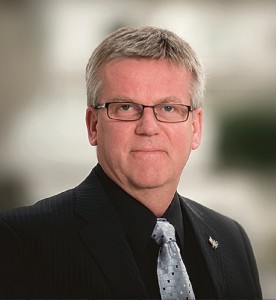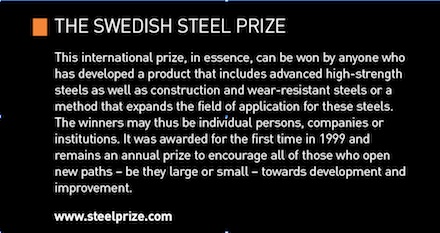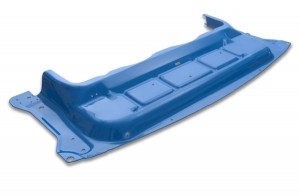
When safety became a key marketing feature for the automotive industry, Swedish steel manufacturer SSAB already had the technical know-how and the products on the market, as Håkan Johansson reports

The Swedish steel manufacturer SSAB started to develop high-strength steel during the 1980s, and a few years later these steel grades were established as the material to use when you wanted to build a crashworthy car. The company had been delivering advanced high-strength steel for protection beams and energy-absorbing zones to the Swedish automotive industry for years. And SSAB’s engineers had the knowledge not only to produce modern steel but also to use it in advanced manufacturing processes.
Roger Lidgren, general manager for automotive products at SSAB Americas, has been involved with advanced high-strength steel for most of his professional life. “Today there are several competitors who also manufacture advanced high-strength steel, but thanks to good quality and even properties SSAB still keep ahead of them,” says Lidgren.
In the beginning, SSAB’s advanced high-strength steel brand, Docol, was used to build safer cars. “But today there are other properties that are at least as important,” he says. “Our best steel grades are a part of the solution when it comes to creating a more environmentally sound world for the future. Car manufacturers use high-strength steel to make lighter but still safe products”. There is an example of this in the Future Steel Vehicle (FSV) concept study conducted by WorldAutoSteel, the automotive group of the World Steel Association (worldsteel) of which SSAB is a member.
 Roger Lidgren, general manager for automotive products at SSAB Americas
Roger Lidgren, general manager for automotive products at SSAB Americas“Car body structures consist more and more of advanced high-strength steel,” says Lidgren. “But, as the study highlighted, it could be used much more.”
The FSV study gives an example of the weight benefits which can be achieved by using high-strength steel. The designers of the concept managed to reduce the weight of a car body by more than 35% compared with a baseline vehicle with an internal combustion engine. Reduced weight leads to better fuel efficiency and a reduction of greenhouse gas emissions. The results show that by incorporating FSV’s materials and manufacturing technologies, car companies can avoid pursuing more costly alternatives and complicated multi-material designs to achieve their goals. SSAB is an appreciated company in the US. With the name comes trust and reliability.
“After living here for more than ten years, I know that being a Swedish company gives us an advantage,” says Lidgren. “We are proud of our origin, but today we have our own steel plant in the US and have grown stronger than ever on the North American continent. This makes us a valued partner to several automotive companies. We are certainly bigger but still flexible when it comes to delivery and support”.
Support: A core issue
Technical customer support has always been a core issue at SSAB. Lidgren says that this is one of the secrets of SSAB’s success in the market: “Our technical support team travel all over the US, ready to help our customers to solve any kind of problems regarding the use of Docol”.
“Quite often, our specialists work together with the customers’ R&D departments or designers to create the next generation of their products. That’s when it is as good as it gets; from a blank paper, the new products are developed making use of our steel grades”.
 Several success stories
Several success stories
Over the years, Lidgren has seen several success stories. SSAB established the Swedish Steel Prize, an award for innovative use of advanced high-strength steel. Since the start in 1998, there have been several US companies awarded in the final ceremony in Stockholm, the capital of Sweden, shortly before the Nobel Prize winners are awarded in the same city.
“I have personally been involved in at least three of the awarded applications”, says Lidgren. “A US-based company developed a crashworthy battery holder manufactured from ultra-high-strength steel for the batteries powering the Ford Escape Hybrid SUV. The battery holder was produced using press tools of advanced design which represent a major technical advance in working with high-strength steels. This opened the way for regular production of large components made from very high-strength steels”.
The Su-Dan Corporation was one of two winners of the Swedish Steel Prize, with a resilient steel strip which replaced an earlier version made of hardened steel. Production economy has been greatly improved as the thickness of the strip has been halved and rejections and heat treatment have been eliminated.
A third example is the unique design and production method employed by Shape, US, to manufacture bumpers. The product is based on several forming methods and combines various types of ultra high-strength steels to create a closed profile of varying cross-sections. The company further developed its bumper system and offers the automotive industry several ways to optimise the combination of crashworthiness, weight and cost for a variety of car models.
New nominees from the US?
“I look forward to see new nominees from the US being awarded the Swedish Steel Prize in Stockholm,” states Lidgren. “We have a lot of innovative strength among our Docol customers so it is only a question of who is the next one to apply, if you ask me”.
In Scandinavia, SSAB recently merged with the Finnish steel manufacturer Rukki. Within the next 12 months, SSAB will launch several brand-new steel grades, which will create new opportunities in the automotive sector in the US. “Most important is a programme with new galvanised high-strength steel products,” says Lidgren. When SSAB concentrates its hot-dip galvanising facilities in Finland, the properties of the products are expected to fulfil and exceed all OEM demand.
 A crashworthy battery holder SSAB manufactured from ultra-high strength steel for the batteries powering the Ford Escape Hybrid SUV
A crashworthy battery holder SSAB manufactured from ultra-high strength steel for the batteries powering the Ford Escape Hybrid SUV“And we already know, many customers are just waiting for the opportunity to buy these new products from us,” says Lidgren. “It really will be an attractive alternative to the electro-galvanised products that are standard today”.
SSAB is developing new, advanced high-strength steel products which are more or less tailor-made with a combination of ductility, corrosion resistance and tensile strength/energy absorption. This development is a result of the investments made in the steel plant in Sweden during 2010. As a consequence, the SSAB R&D department could develop totally new, advanced high-strength steel products. They are extremely strong, but also ductile enough for the tough demands of the automotive industry.
All through the lifecycle
Advanced high-strength steel has its advantages all through the lifecycle of a product such as a car; from the manufacturing of the steel, through the mill producing the steel sheet to punching, bending, welding and assembling the steel parts in a new car. “But it is even more beneficial for the final customer,” says Lidgren. “Low weight pays off in reduced fuel consumption and less carbon dioxide emissions throughout the life span of the vehicle. And if something happens, it is easier to repair a car made of high-strength steel. All workshops have experience of working with steel; how many know about carbon, plastics and aluminium?”































